(b) Given his recent diagnosis, advise Stuart as to which of the two proposed investments (Omikron plc/Omegaplc) would be the more tax efficient alternative. Give reasons for your choice. (3 marks)
题目
(b) Given his recent diagnosis, advise Stuart as to which of the two proposed investments (Omikron plc/Omega
plc) would be the more tax efficient alternative. Give reasons for your choice. (3 marks)
相似考题
更多“(b) Given his recent diagnosis, advise Stuart as to which of the two proposed investments (Omikron plc/Omegaplc) would be the more tax efficient alternative. Give reasons for your choice. (3 marks)”相关问题
-
第1题:
(b) Explain the capital gains tax (CGT) and inheritance tax (IHT) implications of Graeme gifting his remaining ‘T’
ordinary shares at their current value either:
(i) to his wife, Catherine; or
(ii) to his son, Barry.
Your answer should be supported by relevant calculations and clearly identify the availability and effect of
any reliefs (other than the CGT annual exemption) that might be used to reduce or defer any tax liabilities
arising. (9 marks)
正确答案: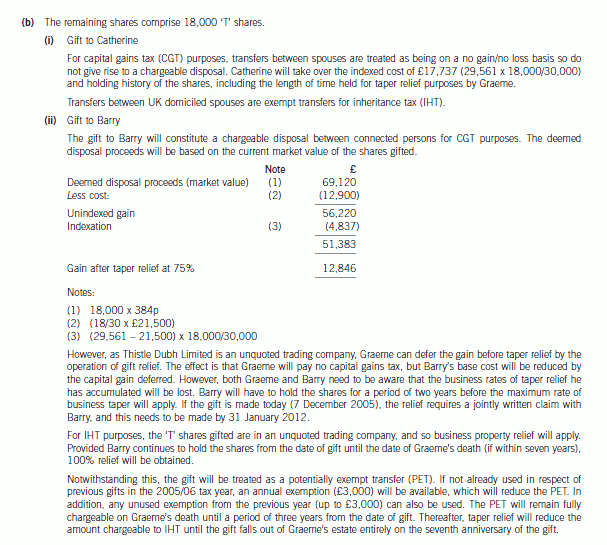
-
第2题:
(c) Advise Alan on the proposed disposal of the shares in Mobile Ltd. Your answer should include calculations
of the potential capital gain, and explain any options available to Alan to reduce this tax liability. (7 marks)
正确答案: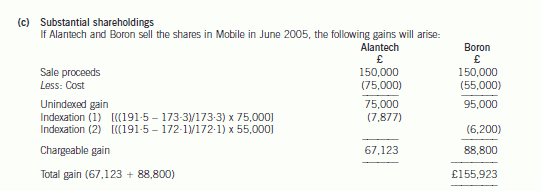
However, an exemption from corporation tax exists for any gain arising when a trading company (or member of a trading
group) sells the whole or any part of a substantial shareholding in another trading company.
A substantial shareholding is one where the investing company holds 10% of the ordinary share capital and is beneficially
entitled to at least 10% of the
(i) profits available for distribution to equity holders and
(ii) assets of the company available for distribution to equity holders on a winding up.
In meeting the 10% test, shares owned by a chargeable gains group may be amalgamated. The 10% test must have been
met for a continuous 12 month period during the 2 years preceding the disposal.
The companies making the disposals must have been trading companies (or members of a trading group) throughout the
12 month period, as well as at the date of disposal. In addition, they must also be trading companies (or members of a trading
group) immediately after the disposal.
The exemption is given automatically, and acts to deny losses as well as eliminate gains.
While Alantech Ltd has owned its holding in Mobile Ltd for 33 months, its ownership of the Boron holding has only lasted
for 10 months (at 1 June 2005) since Boron was acquired on 1 July 2004. Selling the shares in June 2005 will fail the
12 month test, and the gain will become chargeable.
It would be better for the companies to wait for a further month until July 2005 before selling the amalgamated shareholding.
By doing so, they will both be able to take advantage of the substantial shareholdings relief, thereby saving tax of £29,625
assuming a corporation tax rate of 19%. -
第3题:
(b) (i) Advise Benny of the income tax implications of the grant and exercise of the share options in Summer
Glow plc on the assumption that the share price on 1 September 2007 and on the day he exercises the
options is £3·35 per share. Explain why the share option scheme is not free from risk by reference to
the rules of the scheme and the circumstances surrounding the company. (4 marks)
正确答案:
(b) (i) The share options
There are no income tax implications on the grant of the share options.
In the tax year in which Benny exercises the options and acquires the shares, the excess of the market value of the
shares over the price paid, i.e. £11,500 ((£3·35 – £2·20) x 10,000) will be subject to income tax.
Benny’s financial exposure is caused by the rule within the share option scheme obliging him to hold the shares for a
year before he can sell them. If the company’s expansion into Eastern Europe fails, such that its share price
subsequently falls to less than £2·20 before Benny has the chance to sell the shares, Benny’s financial position may be
summarised as follows:
– Benny will have paid £22,000 (£2·20 x 10,000) for shares which are now worth less than that.
– He will also have paid income tax of £4,600 (£11,500 x 40%). -
第4题:
(ii) Explain, with reasons, the relief available in respect of the fall in value of the shares in All Over plc,
identify the years in which it can be claimed and state the time limit for submitting the claim.
(3 marks)
正确答案:
-
第5题:
(ii) Assuming the relief in (i) is available, advise Sharon on the maximum amount of cash she could receive
on incorporation, without triggering a capital gains tax (CGT) liability. (3 marks)
正确答案:
(ii) As Sharon is entitled to the full rate of business asset taper relief, any gain will be reduced by 75%. The position is
maximised where the chargeable gain equals Sharon’s unused capital gains tax annual exemption of £8,500. Thus,
before taper relief, the gain she requires is £34,000 (1/0·25 x £8,500).
The amount to be held over is therefore £46,000 (80,000 – 34,000). Where part of the consideration is in the form
of cash, the gain eligible for incorporation relief is calculated using the formula:
Gain deferred = Gain x value of shares issued/total consideration
The formula is manipulated on the following basis:
£46,000 = £80,000 x (shares/120,000)
Shares/120,000 = £46,000/80,000
Shares = £46,000 x 120,000/80,000
i.e. £69,000.
As the total consideration is £120,000, this means that Sharon can take £51,000 (£120,000 – £69,000) in cash
without any CGT consequences. -
第6题:
(c) For commercial reasons, Damian believes that it would be sensible to place a new holding company, Bold plc,
over the existing company, Linden Limited. Bold plc would also be unquoted and would acquire the existing
Linden Limited shares in exchange for the issue of its own shares.
If the new structure is implemented, Bold plc will provide management services to Linden Limited, but the
amount that will be charged for these services is yet to be determined.
Required:
(i) State the capital gains tax (CGT) issues that Damian should be aware of before disposing of his shares
in Linden Limited to Bold plc. Your answer should include details of any conditions that will need to be
satisfied if an immediate charge to tax is to be avoided. (4 marks)
正确答案:
(c) (i) The proposed transaction broadly falls under the ‘paper for paper’ rules. Where this is the case, chargeable gains do not
arise. Instead, the new holding stands in the shoes (and inherits the base cost) of the original holding.
The company issuing the new shares must:
(i) end up with more than 25% of the ordinary share capital or a majority of the voting power of the old company,
OR
(ii) make a general offer to shareholders in the old company with a condition which would give the acquiring company
control of the company if accepted.
The exchange must be for bona fide commercial reasons and not have as its main purpose (or one of its main purposes)
the avoidance of capital gains tax or corporation tax.
The issue of shares by Bold plc satisfies these conditions, thus Damian, as a shareholder of Linden Limited, will not be
taxed on the exchange of shares. -
第7题:
(b) Advise on the capital gains implications should Trent Limited’s old building be sold as proposed. Support your
advice with relevant calculations. (4 marks)
正确答案:
This gives a higher post-entry loss of £50,000 (150,000 – 100,000) and so it is advisable for Trent Limited to make
this election.
The £100,000 of pre-entry losses are still available, but can only be set against gains on assets which:
(i) Trent Limited sold prior to being acquired (subject to the normal carry back restrictions), or
(ii) Trent Limited already owned when it was acquired, or
(iii) Trent Limited acquired from outside the group and used in its trade after being bought by Tay Limited. -
第8题:
(b) (i) Advise Andrew of the income tax (IT) and capital gains tax (CGT) reliefs available on his investment in
the ordinary share capital of Scalar Limited, together with any conditions which need to be satisfied.
Your answer should clearly identify any steps that should be taken by Andrew and the other investors
to obtain the maximum relief. (13 marks)
正确答案:
(b) (i) Andrew may be able to take advantage of tax reliefs under the enterprise investment scheme (EIS) provided the
necessary conditions are met. The conditions that have to be satisfied before full relief is available fall into three areas,
and broadly require that a ‘qualifying individual’ subscribes for ‘eligible shares’ in a ‘qualifying company’.
‘Qualifying Individual’
To be a qualifying individual, Andrew must not be connected with the EIS company. This means that he should not be
an employee (or, at the time the shares are issued, a director) or have an interest in (i.e. control) 30% or more of the
capital of the company. These conditions need to be satisfied throughout the period beginning two years before the share
issue and three years after the ‘relevant date’. Where the relevant date is defined as the later of the date the shares were
issued and the date on which the company commenced trading.
Andrew does not intend to become an employee (or director) of Scalar Limited, but he needs to exercise caution as to
how many shares he subscribes for. If only three investors subscribe for 100% of the shares, each will hold 33% of the
share capital. This exceeds the 30% limit and will mean that EIS relief (other than deferral relief) will not be available.
Therefore, Andrew and the other two investors should ensure not only that the potential fourth investor is recruited, but
that s/he subscribes for sufficient shares, such that none of them will hold 30% or more of the issued share capital, as
only then will they all attain qualifying individual status.
‘Eligible shares’
Qualifying shares need to be new ordinary shares which are subscribed for in cash and fully paid up at the time of issue.
The shares must not be redeemable for at least three years from the relevant date, and not carry any preferential rights
to dividends. On the basis of the information provided, the shares of Scalar Limited would qualify as eligible shares.
‘Qualifying Company’
The company must be unquoted, not controlled by another company, and engaged in qualifying business activities. The
latter requires that the company engage in a trading activity, which is carried on wholly or mainly in the UK, throughout
the three years following the relevant date. While certain trading activities, such as dealing in shares or trading in land,
are excluded, the manufacturing trade Scalar Limited proposes to carry on will qualify.
However, it is also necessary for at least 80% of the money raised to be used for the qualifying business activity within
12 months of the relevant date and the remaining 20% to be so used within the following 12 months. Andrew and the
other investors will thus have to ensure that Scalar Limited has not raised more funds than it is able to employ in the
business within the appropriate time periods.
Reliefs available:
Andrew can claim income tax relief at 20% income tax relief on the amount invested up to a maximum of £200,000
in any one tax year. The relief is given in the form. of a tax reducing allowance, which can reduce the investor’s income
tax liability to nil, but cannot be used to generate a tax refund. If the investment is made prior to 6 October in the tax
year, then 50% of the amount invested (up to a maximum of £25,000) can be treated as having been made in the
previous tax year.
Any capital gains arising on the sale of EIS shares will be fully exempt from capital gains tax provided that income tax
relief was given on the investment when made and has not been withdrawn. If the EIS shares are disposed of at a loss,
capital losses are still allowable, but reduced by the amount of any EIS relief attributable to the shares disposed of.
In addition, gains from the disposal of other assets can be deferred against the base cost of EIS shares acquired within
one year before and three years after their disposal. Such gains will, thus, not normally become chargeable until the EIS
shares themselves are disposed of. Further, for deferral relief to be available, it is not necessary for the investment to
qualify for EIS income tax relief, i.e. deferral is available even where the investor is not a qualifying individual. Thus,
Andrew could still defer the gain arising on the disposal of the residential property lease made in order to raise part of
the funds for his EIS investment, even if no fourth investor were to be found and his shareholding were to exceed 30%
of the issued share capital of Scalar Limited. Does not require the existence of income tax relief in order to be claimed.
Withdrawal of relief:
Any EIS relief claimed by Andrew will be withdrawn (partially or fully) if, within three year of the relevant date:
(1) he disposes of the shares;
(2) he receives value from the company;
(3) he ceases to be a qualifying individual; or
(4) Scalar Limited ceases to be a qualifying company.
With regard to receiving value from the company, the definition excludes dividends which do not exceed a normal rate
of return, but does include the repayment of any loans made to the company before the shares were issued, the provision
of benefits and the purchase of assets from the company at an undervalue. In this regard, Andrew and the other
subscribers should ensure that the £50,000 they are to invest in Scalar Limited as loan capital is appropriately timed
and structured relative to the issue of the EIS shares. -
第9题:
(ii) Advise Mr Fencer of the income tax implications of the proposed financing arrangements. (2 marks)
正确答案:
(ii) The income tax implications of the proposed financing arrangements
Mr Fencer has borrowed money from a UK bank in order to make a loan to Rapier Ltd, a close company. The interest
paid by Mr Fencer to the bank will be an allowable charge on income as long as he continues to hold more than 5% of
Rapier Ltd. Charges on income are deductible in arriving at an individual’s statutory total income.
Mr Fencer will receive interest from Rapier Ltd net of 20% income tax. The gross amount of interest will be subject to
income tax at either 10%, 20% or 40% depending on whether the income falls into Mr Fencer’s starting rate, basic rate
or higher rate tax band. Mr Fencer will obtain a tax credit for the 20% income tax suffered at source. -
第10题:
(ii) A proposal which will increase the after tax proceeds from the sale of the Snapper plc loan stock and a
reasoned recommendation of a more appropriate form. of external finance. (3 marks)
正确答案:
(ii) Proposal to increase the after tax proceeds from the sale of the loan stock
AS should delay the sale of the loan stock until after 5 April 2008. The gain made at the time of the takeover would
then crystallise in 2008/09 and would be covered by the annual exemption for that year. The net proceeds would be
increased by the capital gains tax saved of £3,446 (£8,616 x 40%).
More appropriate forms of external finance
A bank overdraft is not the most appropriate form. of long term business finance. This is because the bank can demand
repayment of the overdraft at any time and the rates of interest charged are fairly high.
AS should seek long term finance for his long term business needs, for example a bank loan secured on the theatre, and
use the bank overdraft to finance the working capital required on a day-to-day basis. -
第11题:
(b) State the immediate tax implications of the proposed gift of the share portfolio to Avril and identify an
alternative strategy that would achieve Crusoe’s objectives whilst avoiding a possible tax liability in the
future. State any deadline(s) in connection with your proposed strategy. (5 marks)
正确答案:
(b) Gift of the share portfolio to Avril
Inheritance tax
The gift would be a potentially exempt transfer at market value. No inheritance tax would be due at the time of the gift.
Capital gains tax
The gift would be a disposal by Crusoe deemed to be made at market value for the purposes of capital gains tax. No gain
would arise as the deemed proceeds will equal Crusoe’s base cost of probate value.
Stamp duty
There is no stamp duty on a gift of shares for no consideration.
Strategy to avoid a possible tax liability in the future
Crusoe should enter into a deed of variation directing the administrators to transfer the shares to Avril rather than to him. This
will not be regarded as a gift by Crusoe. Instead, provided the deed states that it is intended to be effective for inheritance tax
purposes, it will be as if Noland had left the shares to Avril in a will.
This strategy is more tax efficient than Crusoe gifting the shares to Avril as such a gift would be a potentially exempt transfer
and inheritance tax may be due if Crusoe were to die within seven years.
The deed of variation must be entered into by 1 October 2009, i.e. within two years of the date of Noland’s death. -
第12题:
1 Stuart is a self-employed business consultant aged 58. He is married to Rebecca, aged 55. They have one child,
Sam, who is aged 24 and single.
In November 2005 Stuart sold a house in Plymouth for £422,100. Stuart had inherited the house on the death of
his mother on 1 May 1994 when it had a probate value of £185,000. The subsequent pattern of occupation was as
follows:
1 May 1994 to 28 February 1995 occupied by Stuart and Rebecca as main residence
1 March 1995 to 31 December 1998 unoccupied
1 January 1999 to 31 March 2001 let out (unfurnished)
1 April 2001 to 30 November 2001 occupied by Stuart and Rebecca
1 December 2001 to 30 November 2005 used occasionally as second home
Both Stuart and Rebecca had lived in London from March 1995 onwards. On 1 March 2001 Stuart and Rebecca
bought a house in London in their joint names. On 1 January 2002 they elected for their London house to be their
principal private residence with effect from that date, up until that point the Plymouth property had been their principal
private residence.
No other capital disposals were made by Stuart in the tax year 2005/06. He has £29,500 of capital losses brought
forward from previous years.
Stuart intends to invest the gross sale proceeds from the sale of the Plymouth house, and is considering two
investment options, both of which he believes will provide equal risk and returns. These are as follows:
(1) acquiring shares in Omikron plc; or
(2) acquiring further shares in Omega plc.
Notes:
1. Omikron plc is a listed UK trading company, with 50,250,000 shares in issue. Its shares currently trade at 42p
per share.
2. Stuart and Rebecca helped start up the company, which was then Omega Ltd. The company was formed on
1 June 1990, when they each bought 24,000 shares for £1 per share. The company became listed on 1 May
1997. On this date their holding was subdivided, with each of them receiving 100 shares in Omega plc for each
share held in Omega Ltd. The issued share capital of Omega plc is currently 10,000,000 shares. The share price
is quoted at 208p – 216p with marked bargains at 207p, 211p, and 215p.
Stuart and Rebecca’s assets (following the sale of the Plymouth house but before any investment of the proceeds) are
as follows:
Assets Stuart Rebecca
£ £
Family house in London 450,000 450,000
Cash from property sale 422,100 –
Cash deposits 165,000 165,000
Portfolio of quoted investments – 250,000
Shares in Omega plc see above see above
Life insurance policy note 1 note 1
Note:
1. The life insurance policy will pay out a sum of £200,000 on the death of the first spouse to die.
Stuart has recently been diagnosed with a serious illness. He is expected to live for another two or three years only.
He is concerned about the possible inheritance tax that will arise on his death. Both he and Rebecca have wills whose
terms transfer all assets to the surviving spouse. Rebecca is in good health.
Neither Stuart nor Rebecca has made any previous chargeable lifetime transfers for the purposes of inheritance tax.
Required:
(a) Calculate the taxable capital gain on the sale of the Plymouth house in November 2005 (9 marks)
正确答案:
Note that the last 36 months count as deemed occupation, as the house was Stuart’s principal private residence (PPR)
at some point during his period of ownership.
The first 36 months of the period from 1 March 1995 to 31 March 2001 qualifies as a deemed occupation period as
Stuart and Rebecca returned to occupy the property on 1 April 2001. The remainder of the period will be treated as a
period of absence, although letting relief is available for part of the period (see below).
The exempt element of the gain is the proportion during which the property was occupied, real or deemed. This is
£138,665 (90/139 x £214,160).
(2) The chargeable gain is restricted for the period that the property was let out. This is restricted to the lowest of the
following:
(i) the gain attributable to the letting period (27/139 x 214,160) = £41,599
(ii) £40,000
(iii) the total exempt PPR gain = £138,665
i.e. £40,000.
(3) The taper relief is effectively wasted, having restricted losses b/f to preserve the annual exemption. -
第13题:
(b) Assuming that the income from the sale of the books is not treated as trading income, calculate Bob’s taxable
income and gains for all relevant tax years, using any loss reliefs in the most tax-efficient manner. Your
answer should include an explanation of the loss reliefs available and your reasons for using (or not using)
them. (12 marks)
Assume that the rates and allowances for 2004/05 apply throughout this part of the question.
正确答案:
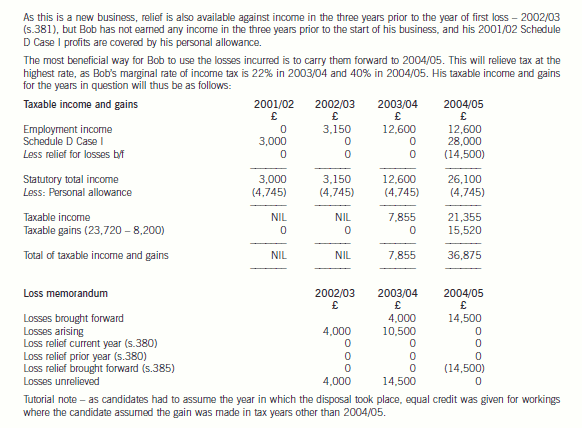
-
第14题:
(b) Mabel has two objectives when making the gifts to Bruce and Padma:
(1) To pay no tax on any gift in her lifetime; and
(2) To reduce the eventual liability to inheritance tax on her death.
Advise Mabel which item to gift to Bruce and to Padma in order to satisfy her objectives. Give reasons for
your advice.
Your advice should include a computation of the inheritance tax saved as a result of the two gifts, on the
assumption that Mabel dies on 30 June 2011. (10 marks)
正确答案: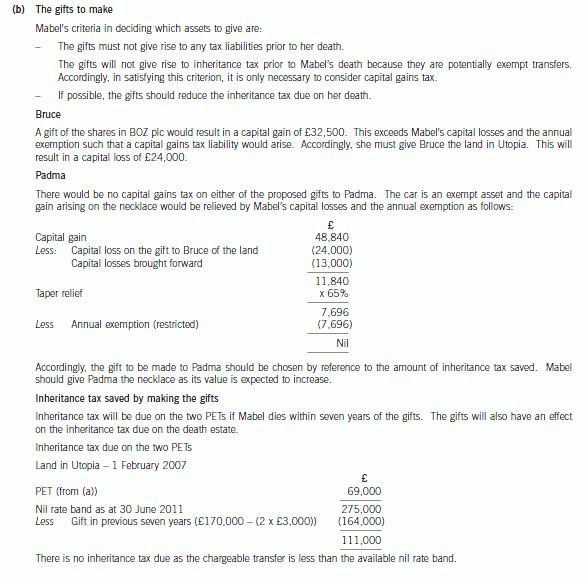

-
第15题:
(c) Outline the ways in which Arthur and Cindy can reduce their income tax liability by investing in unquoted
shares and recommend, with reasons, which form. of investment best suits their circumstances. You are not
required to discuss the qualifying conditions applicable to the investment vehicle recommended. (5 marks)
You should assume that the income tax rates and allowances for the tax year 2005/06 apply throughout this
question
正确答案:
(c) Reduction of income tax liability by investing in unquoted shares
The two forms of investment
Income tax relief is available for investments in venture capital trusts (VCTs) and enterprise investment scheme (EIS) shares.
A VCT is a quoted company that invests in shares in a number of unquoted trading companies. EIS shares are shares in
qualifying unquoted trading companies.
Recommendation
The most suitable investment for Arthur and Cindy is a VCT for the following reasons.
– An investment in a VCT is likely to be less risky than investing directly in EIS companies as the risk will be spread over
a greater number of companies.
– The tax deduction is 40% of the amount invested as opposed to 20% for EIS shares.
– Dividends from a VCT are not taxable whereas dividends on EIS shares are taxed in the normal way. -
第16题:
(c) Prepare brief notes for the proposed meeting with Charles and Jane. Clearly identify the further information
you would need in order to advise them more fully and suggest appropriate personal financial planning
protection products, in respect of both death and serious illness. (9 marks)
You should assume that the income tax rates and allowances for the tax year 2005/06 and the corporation tax
rates for the financial year 2005 apply throughout this question.
正确答案: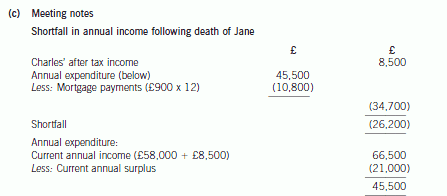
When considering the shortfall
– The family’s expenditure is likely to increase as the children get older, particularly if there is a need for school fees.
– There will be a need for some cash immediately to pay for the cost of the funeral.
– It is assumed that the whole of Jane’s estate has been left to Charles such that there will be no inheritance tax on her
death.
– The shortfall may be reduced by:
(i) State benefits and tax credits.
(ii) Expenditure on non-essential items, e.g. holidays and entertainment included in the annual expenditure of
£45,500.
(iii) The income generated by Charles if he were to return to work.
– The shortfall may be increased by additional child-care costs due to Charles being a single parent, particularly if he
returns to work full-time.
Further information required
– The level of state benefits and tax credits available to Charles.
– The current level of expenditure on non-essential items.
– The costs of child-care if Charles were to return to work.
– Details of any wills made by Charles or Jane.
– Whether Charles’ investment properties could be sold and the proceeds invested in assets with a higher annual return.
– Whether there is any value in Speak Write Ltd independent of Jane, such that the company could be sold after Jane’s
death.
Other related issues
– The couple should consider making provision for their retirement via pension contributions or some other form. of long
term investment plan.
– The couple should recognise that there would be significant financial problems if Jane were to become seriously ill. In
addition to the family’s income falling as set out above, its expenditure would probably increase.
Protection products
– Term life assurance
A qualifying life policy would pay out a tax-free lump sum on Jane’s death.
– Permanent health insurance
Would provide a regular income if Jane were unable to work due to illness.
– Critical illness insurance
Would provide a capital sum in the event of Jane being diagnosed with an insured illness. -
第17题:
(ii) Calculate Paul’s tax liability if he exercises the share options in Memphis plc and subsequently sells the
shares in Memphis plc immediately, as proposed, and show how he may reduce this tax liability.
(4 marks)
正确答案:
-
第18题:
(ii) Following on from your answer to (i), evaluate the two purchase proposals, and advise Bill and Ben
which course of action will result in the highest amount of after tax cash being received by the
shareholders if the disposal takes place on 31 March 2006. (4 marks)
正确答案: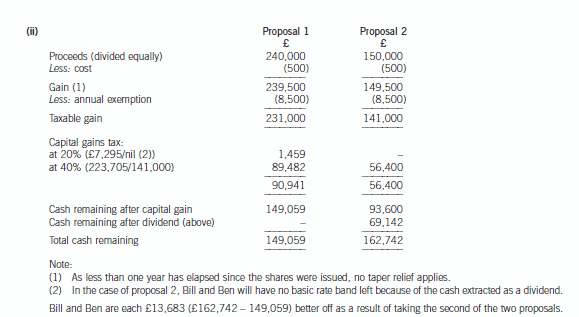
-
第19题:
(ii) Advise Andrew of the tax implications arising from the disposal of the 7% Government Stock, clearly
identifying the tax year in which any liability will arise and how it will be paid. (3 marks)
正确答案:
(ii) Government stock is an exempt asset for the purposes of capital gains tax, however, as Andrew’s holding has a nominal
value in excess of £5,000, a charge to income tax will arise under the accrued income scheme. This charge to income
tax will arise in 2005/06, being the tax year in which the next interest payment following disposal falls due (20 April
2005) and it will relate to the income accrued for the period 21 October 2004 to 14 March 2005 of £279 (145/182
x £350). As interest on Government Stock is paid gross (unless the holder applies to receive it net), the tax due of £112
(£279 x 40%) will be collected via the self-assessment system and as the interest was an ongoing source of income
will be included within Andrew’s half yearly payments on account payable on 31 January and 31 July 2006. -
第20题:
(ii) Advise Clifford of the capital gains tax implications of the alternative of selling the Oxford house and
garden by means of two separate disposals as proposed. Calculations are not required for this part of
the question. (3 marks)
正确答案:
(ii) The implications of selling the Oxford house and garden in two separate disposals
The additional sales proceeds would result in an increase in Clifford’s capital gains and consequently his tax liability.
When computing the gain on the sale of the house together with a small part of the garden, the allowable cost would
be a proportion of the original cost. That proportion would be A/A + B where A is the value of the house and garden
that has been sold and B is the value of the part of the garden that has been retained. Principal private residence relief
and taper relief would be available in the same way as that set out in (i) above.
When computing the gain on the sale of the remainder of the garden, the cost would be the original cost of the property
less the amount used in computing the gain on the earlier disposal. Principal private residence relief would not be
available as the land sold is not a dwelling house or part of one. -
第21题:
(b) Advise Sergio on the appropriateness of investing in a domestic rental property in view of his personal
circumstances and recommend suitable alternative investments giving reasons for your advice. (4 marks)
正确答案:
(b) Sergio’s investments
Sergio aims to leave a substantial asset to his family on his death. Accordingly, in view of his age, he is right to be considering
investing in an asset whose value is unlikely to fall suddenly, such as a domestic rental property. However, it must be
recognised that although the value of land and buildings can usually be relied on to increase over a long period of time, its
value may fall over a shorter period. The only investments that cannot fall in value are cash deposits, although they do, of
course, fall in real terms due to the effects of inflation.
Sergio should consider whether or not he wishes to increase his annual income. The return on capital invested in a domestic
rental property is unlikely to be very high due to the recent increases in property values in the UK. Also, there are likely to be
periods when the house is unoccupied during which no income will be generated. If it is important to Sergio to generate
additional income he should consider other low-risk investments with a more reliable and higher rate of return, for example,
gilt edged stocks, unit trusts and cash deposits.
Sergio must also decide whether it is important to him to be able to access capital quickly, as it is usually not possible to
realise the capital invested in land and buildings at short notice. If this is important, Sergio should consider holding some of
his capital in cash deposits or other liquid investments, eg unit trusts.
Sergio could invest up to £7,000 each year in an individual savings account (ISA). A maximum of £3,000 can be held as a
cash deposit with the balance invested in quoted shares. The income and gains arising on the funds invested would be
exempt from both income tax and capital gains tax. This would be a relatively low-risk investment and would also be
accessible quickly if required. -
第22题:
(c) The inheritance tax payable by Adam in respect of the gift from his aunt. (4 marks)
Additional marks will be awarded for the appropriateness of the format and presentation of the memorandum and
the effectiveness with which the information is communicated. (2 marks)
Note: you should assume that the tax rates and allowances for the tax year 2006/07 will continue to apply for the
foreseeable future.
正确答案:
(c) Inheritance tax payable by Adam
The gift by AS’s aunt was a potentially exempt transfer. No tax will be due if she lives until 1 June 2014 (seven years after
the date of the gift).
The maximum possible liability, on the assumption that there are no annual exemptions or nil band available, is £35,216
(£88,040 x 40%). This will only arise if AS’s aunt dies before 1 June 2010.
The maximum liability will be reduced by taper relief of 20% for every full year after 31 May 2010 for which AS’s aunt lives.
The liability will also be reduced if the chargeable transfers made by the aunt in the seven years prior to 1 June 2007 are
less than £285,000 or if the annual exemption for 2006/07 and/or 2007/08 is/are available. -
第23题:
(b) Advise Maureen on deregistration for the purposes of value added tax (VAT) and any possible alternative
strategy. (8 marks)
An additional mark will be awarded for the effectiveness with which the information is communicated.
(1 mark)
正确答案:
(b) Advice on Maureen’s VAT position
Deregistration
In order to voluntarily deregister for VAT you must satisfy HMRC that the value of your taxable supplies in the next twelve
months will not exceed £62,000. You will then be deregistered with effect from the date of your request or a later date as
agreed with HMRC.
On deregistering you are regarded as making a supply of all stocks and equipment in respect of which input tax has been
claimed. However, the VAT on this deemed supply need only be paid to HMRC if it exceeds £1,000.
Once you have deregistered, you must no longer charge VAT on your sales. You will also be unable to recover the input tax
on the costs incurred by your business. Instead, the VAT you pay on your costs will be allowable when computing your taxable
profits.
You should monitor your sales on a monthly basis; if your sales in a twelve-month period exceed £64,000 you must notify
HMRC within the 30 days following the end of the twelve-month period. You will be registered from the end of the month
following the end of the twelve-month period.
Flat rate scheme
Rather than deregistering you may wish to consider operating the flat rate scheme. This would reduce the amount of
administration as you would no longer need to record and claim input tax in respect of the costs incurred by your business.
Under the flat rate scheme you would continue to charge your customers VAT in the way that you do at the moment. You
would then pay HMRC a fixed percentage of your VAT inclusive turnover each quarter rather than calculating output tax less
input tax. This may be financially advantageous as compared with deregistering; I would be happy to prepare calculations for
you if you wish.
